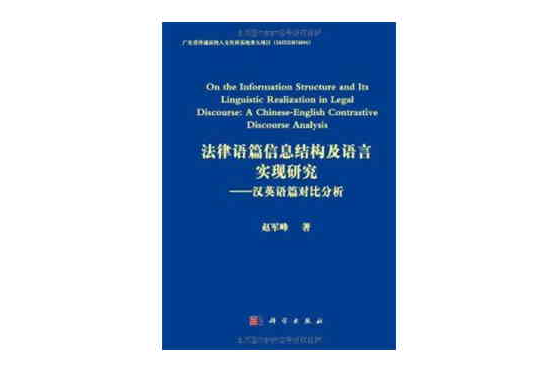《法律語篇信息結構及語言實現研究》是2011年10月出版的圖書,作者是趙軍峰。
基本介紹
- 書名:法律語篇信息結構及語言實現研究
- 作者:趙軍峰
- ISBN:9787030320957
- 頁數:311
- 定價:48.00元
- 出版時間:2011-10
- 副標題:漢英語篇對比分析
內容簡介
目錄
Acknowledgements
Abstract
Chapter 1 Introduction
1.1 Introduction
1.2 Exploring the Nature of Legal Discourse Information Processing
1.3 A Corpus—Based Contrastive Study
1.4 Organization of the Book
Chapter 2 Information Bridges in Contrastive Legal
Discourse Analysis
2.1 Introduction
2.2 Legal Discourse
2.3 Contrastive Discourse Analysis
2.4 Communication, Information and Discourse Analysis
2.4.1 Models of Communication
2.4.2 The Hallidayan Model of Discourse Analysis and Information Structure
2.4.3 Critical Discourse Analysis (CDA)
2.4.4 Appraisal Theory as an Approach to Tackle Interpersonal Meaning
2.4.5 Legal Discourse Information Structure
2.5 The Information Bridges in Contrastive Legal Discourse Analysis
2.5.1 Theoretical Foundings of Information Bridges Model
2.5.2 Description of the Analytical Framework
2.6 A Pilot Study
2.6.1 Introduction
2.6.2 Analysis Based on the Proposed Analytical Framework
2.6.3 A Tentative Conclusion
2.7 Summary
Chapter 3 The Socio—cultural System
3.1 Introduction
3.2 Overview: the Socio—cultural System
3.3 Social Measures
3.4 Ideologies
3.5 Power Relations
3.6 Summary
Chapter 4 The Linguistic Conventions
4.1 Introduction
4.2 General Contrasts Between Chinese and English
4.3 Lexical Choices
4.3.1 Verb—orientation vs.Nominalizations
4.3.2 Personal vs.Impersonal
4.3.3 Stative vs.Dynamic
4.4 Syntactic Structure
4.4.1 Topic—prominent vs.Subject—prominent
4.4.2 Active vs.Passive
4.4.3 Diffusive vs.ComDact
4.4.4 Reiterative vs.Substitutive
4.5 Rhetorical Structure
4.5.1 Paratactic vs.Hypotactic
4.5.2 Direct vs.Indirect
4.5.3 Simplex vs.Complex
4.6 Summary
Chapter 5 The Legal System
5.1 Introduction
5.2 Overview: the Chinese Law vs.the Common Law
5.3 Legal Assumptions
5.3.1 Guilty Presumption vs.Innocent Presumption
5.3.2 Stare Decisis vs.Statutory Decisis
5.4 Institutional Features
5.4.1 Adversarial vs.Inquisitorial
5.4.2 Collegiate Panels vs.Jury System
5.5 Procedural Formalities
5.5.1 Interrogation vs.Interview
5.5.2 Mediation vs.Plea Bargainmg
5.5.3 Judge Dominance vs.Lawyer Dominance
5.6 Summary
Chapter 6 The Discourse Users' Stance
6.1 Introduction
6.2 Affect
6.2.1 Basic vs.Complex
6.2.2 Authorial vs.Non—authorial
6.2.3 Behavioral Surge vs.Mental State
6.3 Judgment
6.3.1 Implicit vs.Explicit
6,3.2 Social Esteem vs.Social Sanction
6,4 Appreciatio
6.4.1 Reaction: Impact vs.Quality
6.4.2 Composition: Balance vs.Complexity
6.4.3 Valuation
6.5 A Comprehensive Analysis of Attitude
6.6 Summary
Chapter 7 Implications and Prospects for Chinese—English Contrastive Studies and Legal Translations
7.1 Introduction
7.2 Summary of Major Findings
7.2.1 Determining Factors
7.2.2 For Optimal Legal Information Transmission
7.2.3 Similarities and Differences
7.3 Conclusion
7.4 Implications for Chinese—English Legal Translations
7.5 Limitations of the Research
7.6 Prospects for Further Research
References
Appendices
Appendix Ⅰ A Tagged Sample of an English Judgment
Appendix Ⅱ Tagged Sample of a Chinese Court Judgment
Appendix Ⅲ Tagging Symbols for the CLIPS
Appendix Ⅳ Tagging Symbols for Information Elements

